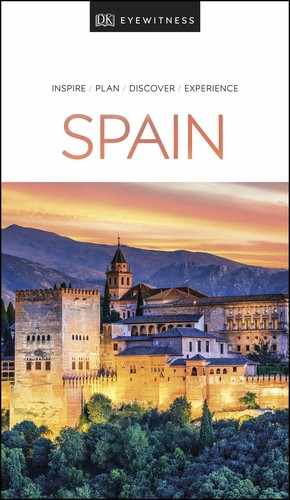Experience More
Since 1596, the Renaissance Generalitat has been the seat of the Governor of Catalonia. Above the entrance is a statue of Sant Jordi (St George), the patron saint of Catalonia, and the Dragon.
Inside are the Gothic chapel of Sant Jordi, designed by Marc Safont, and Pere Blai’s Italianate Saló de Sant Jordi. Don’t miss the Pati dels Tarongers (the Orange Tree Patio), by Pau Mateu, which has a bell tower built by Pere Ferrer in 1568.
The Catalan president has offices here as well as in the Casa dels Canonges. The two buildings are connected by a bridge across Carrer del Bisbe, built in 1928 and modelled on the Bridge of Sighs in Venice.

t The magnificent Sant Jordi chapel, inside the Palau de la Generalitat
The magnificent 14th-century city hall faces the Palau de la Generalitat. Flanking the entrance are statues of Jaime I, who granted the city rights to elect councillors in 1249, and Joan Fiveller, who levied taxes on court members in the 1500s.
Inside is the huge council chamber, the 14th-century Saló de Cent, built for the city’s 100 councillors. The Saló de les Cròniques, on the first floor, was commissioned for the 1929 International Exhibition and decorated by Josep Maria Sert with murals of momentous events in Catalan history.
One of the numerous branches of the Museu d’Història de Barcelona, this information centre occupies a modern building constructed over what was once the medieval home of Yusef Bonhiac, a Jewish weaver. The touch screen information panels and exhibitions give an excellent overview of the Call (the former Jewish quarter) and the lives of its inhabitants.
Barcelona’s Early Jewish Community
From the 11th to the 13th centuries, Jews dominated Barcelona’s commerce and culture, providing doctors and founding the first seat of learning. But in 1243, violent anti-Semitism led to the Jews being consigned to a ghetto, El Call. Jews were heavily taxed by the monarch, but in return they also received privileges, as they handled most of Catalonia’s lucrative trade with North Africa. But in 1401, Martin I declared the ghetto to be illegal and the population fled.
The sculptor Frederic Marès i Deulovol (1893–1991) was also a traveller and collector, and this museum is a monument to his eclectic taste. Part of the Royal Palace complex, the building was home to all sorts of dignitaries before Marès occupied a small apartment here.
Opened by the sculptor in 1948, the museum has a collection of Romanesque and Gothic religious art. On the ground and first floors there are stone sculptures, while exhibits on the three floors above range from clocks and antique cameras to pipes and postcards.
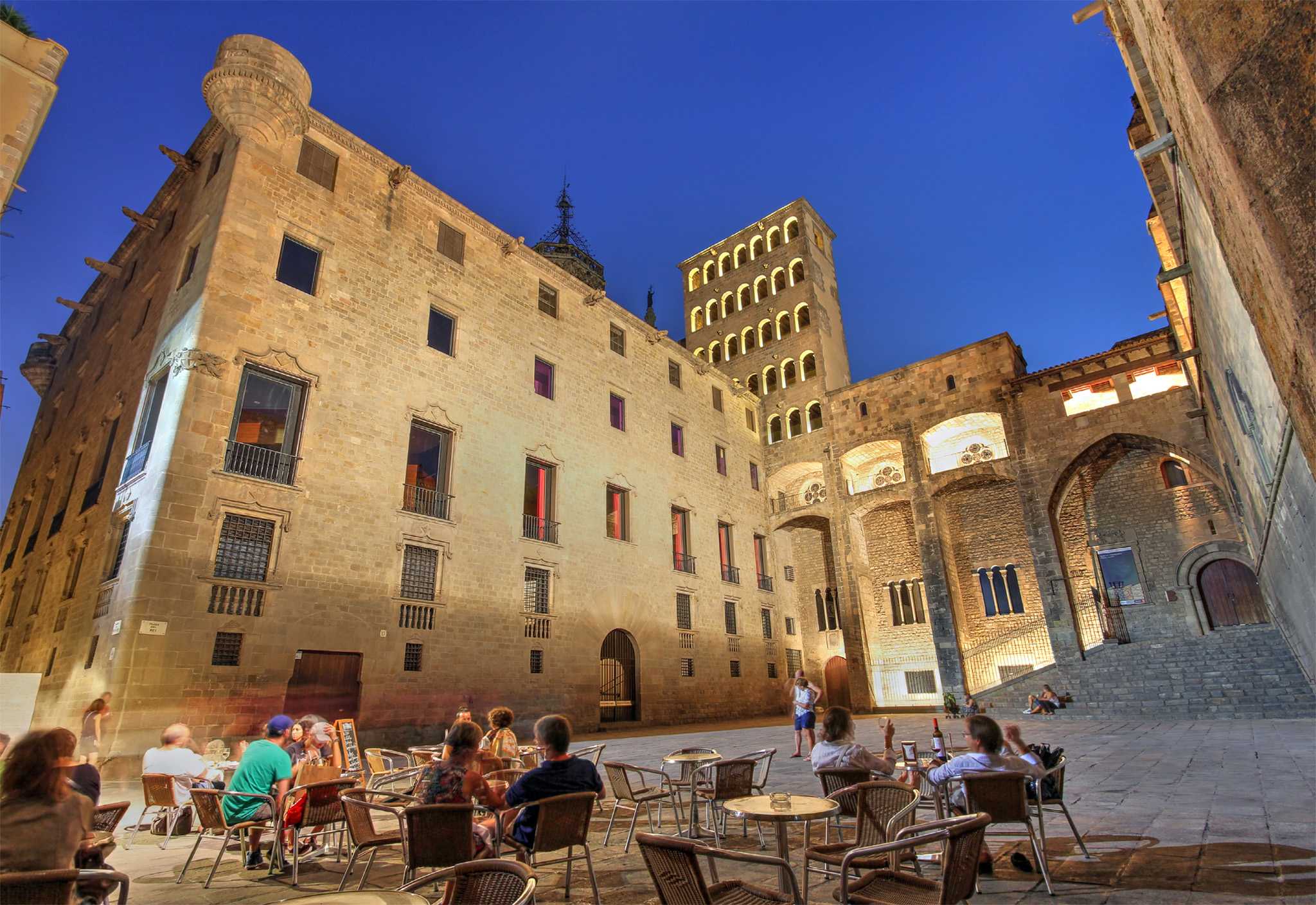
t MUHBA Plaça del Rei, facing onto one of Barcelona’s oldest squares
The Palau Reial (Royal Palace) was the residence of the count-kings of Barcelona from its foundation in the 13th century. The complex includes the Capella Reial de Santa Àgata (royal chapel) and the 14th-century Gothic Saló del Tinell, a vast room with arches spanning 17 m (56 ft). This is where Isabel and Fernando received Columbus on his return from America. It is also where the Holy Inquisition sat, believing that the walls would move if lies were told.
The palace is now part of the Museu d’Història de Barcelona, but its main attraction lies underground. Entire streets of old Barcino are accessible via a lift and walkways suspended over the ruins of Roman Barcelona. Found when the Casa Clariana-Padellàs, the Gothic building from which you enter, was moved here stone by stone in 1931, these are some of the world’s most extensive and complete subterranean Roman ruins.
EXPERIENCE Old Town
|
Stay Chic & Basic Born A good bet for style on a budget, this 19th-century townhouse features small but cleverly designed rooms. H7 ⌂ Calle Princesa 50 ∑ chicandbasic.com ¡¡¡ Banys Orientals The elegant rooms in this 18th-century building are compact but inviting, with modern four-poster beds and romantic low lighting. H7 ⌂ Calle Argenteria 37 ∑ hotelbanysorientals.com ¡¡¡ |
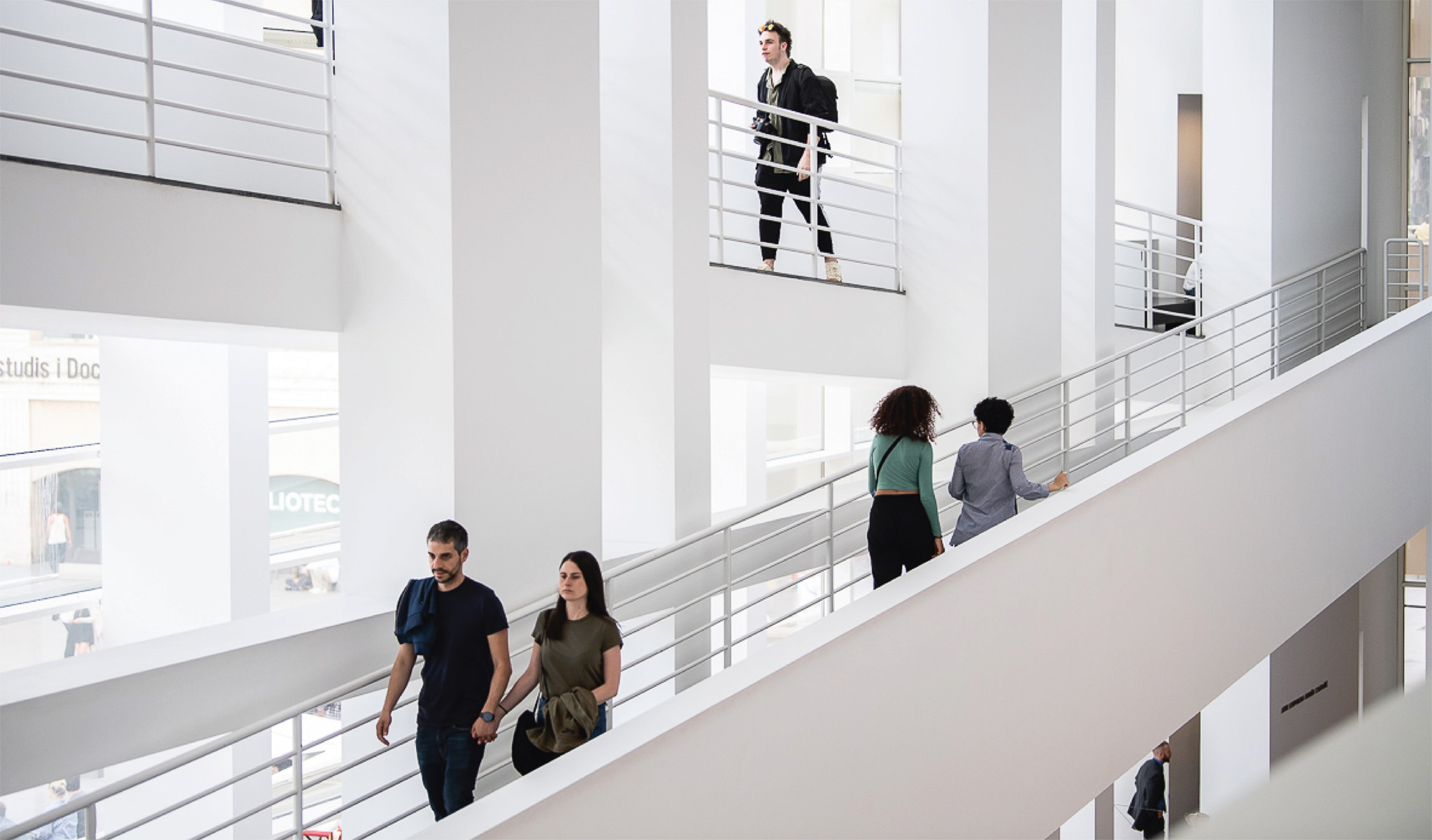
t Visitors exploring the airy interior of the Museu d’Art Contemporani
This dramatic, glass-fronted building, with its light and airy galleries, was designed by the American architect Richard Meier to house the city’s collection of contemporary art.
The permanent collection of predominantly Spanish painting, sculpture and installation from the 1950s onwards is complemented by temporary exhibitions by foreign artists like US painter Susana Solano and South African photo-journalist David Goldblatt.
Next to the MACBA, a remodelled 18th-century hospice, the Casa de la Caritat, houses the Centre de Cultura Contemporània, a lively arts centre that hosts major arts festivals and regular exhibitions, shows and other events.
" ' =
Centre de Cultura Contemporània
⌂ Montalegre 5 # 11am–8pm Tue–Sun & public hols ∑ cccb.org
Standing beside what was originally the Bishop’s Gate in the Roman city wall, the Casa de l’Ardiaca (Archdeacon’s House) was built in the 12th century. Its present appearance, however, dates from around 1500 when it was remodelled and a colonnade was added to the exterior. In 1870 this was extended to form the Flamboyant Gothic patio around a fountain. On Corpus Christi (60 days after Easter Sunday), the “l’ou com balla” (dancing egg) is celebrated here. The fountain is decorated with flowers and fruits and an egg is laid under the water. Instead of falling, the egg turns, seeming to pirouette.
The Modernista architect Lluís Domènech i Montaner added the marble letterbox, carved with three swallows and a tortoise, beside the Renaissance portal. Upstairs is the Arxiu Històric de la Ciutat (City Archives). Visitors are only allowed into the courtyard and the entrance hall, which occasionally hosts art exhibitions.

Insider Tip
Les Nits de Palau Güell
On Thursday nights in summer, the Palau Güell hosts concerts on its unique roof. After you’ve enjoyed the music with a glass of cava, you can take a tour of the building.

t Antoni Gaudí’s unique chimneys atop the Neo-Gothic Palau Güell
Gaudí’s first major work in Barcelona’s city centre was this house, commissioned by his wealthy patron Eusebi Güell. He made it known that, even if he was investing in an inexperienced architect, there would be no limit to the budget at Gaudí’s disposal. Gaudí took Güell at his word, as can be seen in the quality of the materials used for what was a disproportionately grand building for a private residence. The stonework is clad with marble and, inside, high-quality woods are used.
Despite the expense of the build, from the street there is little hint of the colour and playfulness to come in Gaudí’s later work, except in the spire-like chimneys behind the parapet on the roof. The austere façade is symmetrical and characterized mostly by straight lines, both horizontal and vertical. The only indication of Gaudí’s later preference for curves is in the two doorways, which are each formed by a parabolic (U-shaped) arch.
Inside is far more dramatic and typical of Gaudí’s mature designs. It’s easy to see how the architect would later design the Sagrada Família when standing in the central room on the main floor. Something between a sitting room and a covered courtyard, this room rises three floors (of a six-floor building) and is spanned by a cupola.
Ever the perfectionist, Gaudí designed the Palau Güell’s furniture, lights, stained glass and other fittings, as he would do for his future projects.
The house was finished in 1889 and was used by Güell not only as a luxurious family home, but as a place to host important guests, stage chamber concerts and hold political meetings.
Antoni Gaudí (1852–1926)
Born in Reus (Tarragona) into a family of artisans, Antoni Gaudí i Cornet was the leading exponent of Catalan Modernisme. Following a stint as a blacksmith’s apprentice, he studied at Barcelona’s School of Architecture. Inspired by a nationalistic search for a romantic medieval past, his work was supremely original. His first major achievement was the Casa Vicens (1888) at No 24 Carrer de les Carolines, but his most celebrated building is the extravagant church of the Sagrada Família, to which he solely devoted his life from 1914. He gave all his money to the project and often went from house to house begging for more. On 7 June 1926, when Gaudí was knocked over by a tram, no one knew who he was and he was taken to the Hospital de Santa Creu. He died three days later. His funeral was a huge event, and most of Barcelona’s citizens turned out to pay their respects to the man who had transformed their city.
Did You Know?
When Gaudí died, he was mistaken for a beggar because of his unkempt appearance.
EXPERIENCE Old Town
Gaudí’s City

t Gaudí’s famous salamander, covered in brightly coloured mosaics, at Park Güell
Barcelona bears the indelible mark of Catalonia’s most famous son, Antoni Gaudí i Cornet, who transformed the city’s skyline into an architectural masterpiece. Drawing on Persian and Japanese arts, Mudéjar architecture and the natural world, Gaudí reinvented the already adventurous art and architectural style known as Catalan Modernisme. A highly dexterous architect, Gaudí designed, or collaborated on designs, in almost every known medium. He combined bare, undecorated materials – wood, rough-hewn stone, rubble and brickwork – with meticulous craftwork in wrought iron, stained glass and elaborate mosaics. Every Gaudí creation is unique, but they are united by their skill and romanticism.
EXPERIENCE Old Town
Gaudí Highlights |
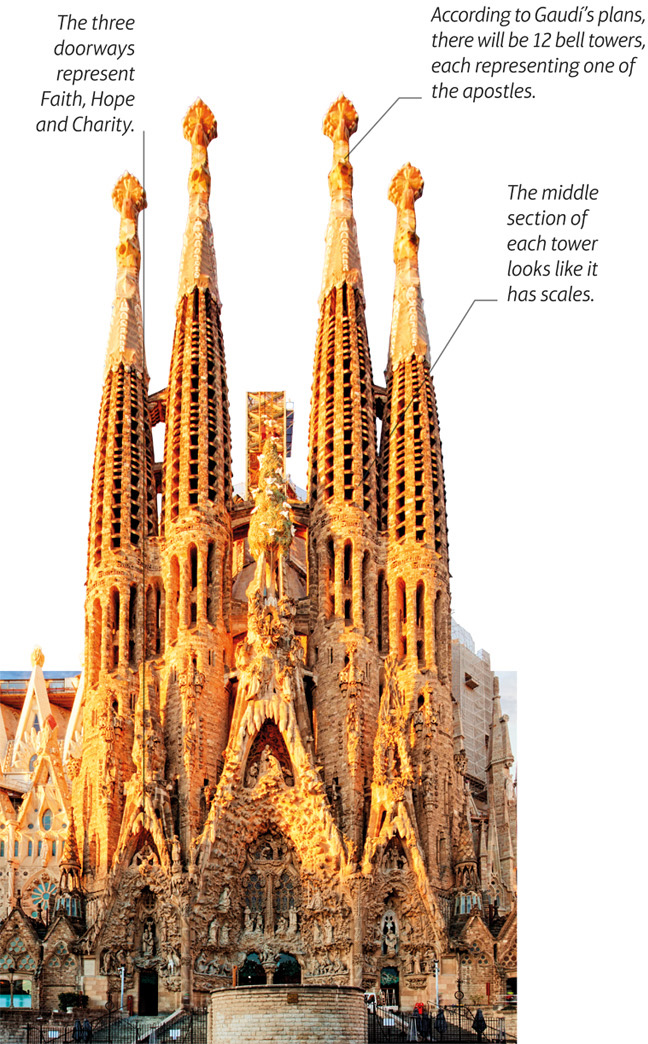
Sagrada FamíliaWhen Gaudí took over the construction of the Sagrada Família in 1883, it became his lifelong obsession. An extreme expression of devotion, his soaring interior and the Nativity façade reference both biblical events and the natural world. Although he never lived to see its completion, it is still built to his vision. |
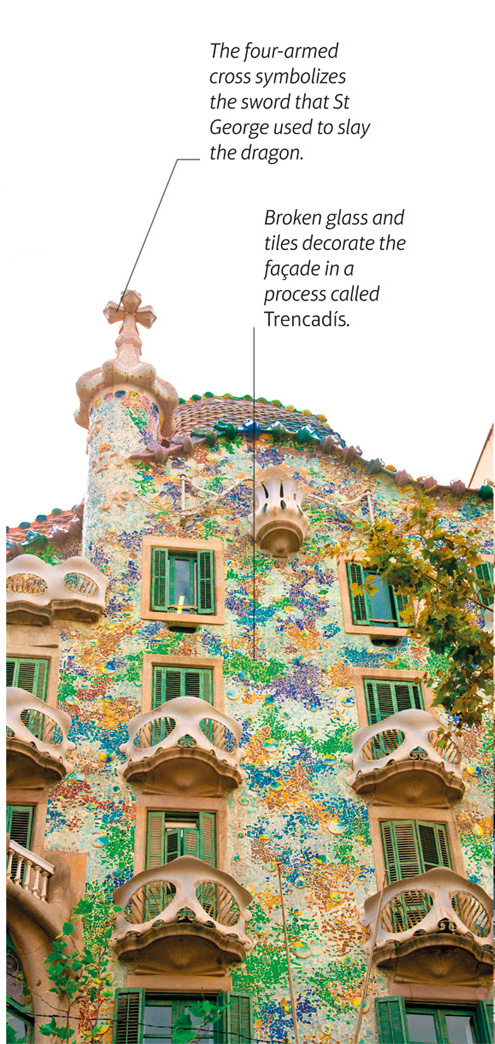
Casa BatllóIndustrialist Josep Batlló gave Gaudí complete creative freedom to reform this late-19th-century house. Completed in 1906, Casa Batlló is an evocation of artistic joy. The façade acted as an exuberant and marine-inspired canvas, while the roof ripples like a dragon in flight. Inside, light pours in through effervescent stained glass, while the central patio ensures natural light reaches every room. |

La PedreraThe last private residence to be designed by Gaudí, rough-hewn La Pedrera raised eyebrows in its time due to its undulating stone façade, abstract roof sculptures and opera-mask-like balconies. The entrance doors, designed to facilitate both people and vehicles, are made up of smaller panes of glass in irregular shapes, based on animals and plants, with larger, more luminous pieces at the top. |

Park GüellBelonging to Gaudí’s naturalist phase, Park Güell is emblematic of the architect’s fanciful style. The stone-built pavilions, with their brightly tiled gingerbread roofs, are like something from a fairy-tale. One of these lodges was designed to be the Casa del Guarda (Caretaker’s House). Initially conceived to be a garden city for Barcelona’s wealthy families, only two plots were purchased. |

t The pink brick façade of the Arc del Triomf, on Passeig de Lluís Companys
The main gateway to the 1888 Universal Exhibition, which filled the Parc de la Ciutadella, was designed by Josep Vilaseca i Casanovas. It is built of brick in Mudéjar style, with sculpted allegories of crafts, industry and business. The frieze by Josep Reynés on the main façade represents the city welcoming foreign visitors and the frieze facing the park shows the city presenting medals to the exhibition participants. Reliefs on one side symbolize agriculture and industry, and commerce and art on the other. Visitors can climb to the viewing terrace at the top of the arch during the 48h Open House Barcelona festival, usually held at the end of October.
Did You Know?
The Arc del Triomf is topped by the 50 shields of each Spanish province.
This covered market, with its ornate ironwork and crystal roof, was Barcelona’s main wholesale market until the early 1970s, when it outgrew its location.
While the market was being remodelled, extensive ruins of the 18th-century city were discovered beneath its foundations. These ruins are now the focal point of the El Born cultural centre, set off by exhibitions, talks and screenings.
The street names in the vicinity reflect what went on in Barcelona’s former mercantile hub: Flassaders was where you would go for a woven blanket and VidrierÍa was once lit up with glass-blowers’ torches. A few of these establishments remain, but they are now outnumbered by chic fashion and interiors boutiques.
Much of this area was razed after Barcelona fell to the French-Spanish forces during the War of Succession. This key event is remembered each year on 11 September, with activities focused on a monument dedicated to those who died in 1714, located near the market.
EXPERIENCE Old Town
|
Eat The El Born district is teeming with tapas bars. Here are a few of the best. Llamber H7 ⌂ Carrer de la Fusina 5 ∑ Llamber.com ¡¡¡ Tapeo Born H7 ⌂ Carrer de Montcada 29 ∑ tapeoborn.cat ¡¡¡ Ale&Hop H6 ⌂ Carrer de les Basses de Sant Pere 10 § 93 126 90 94 ¡¡¡ |
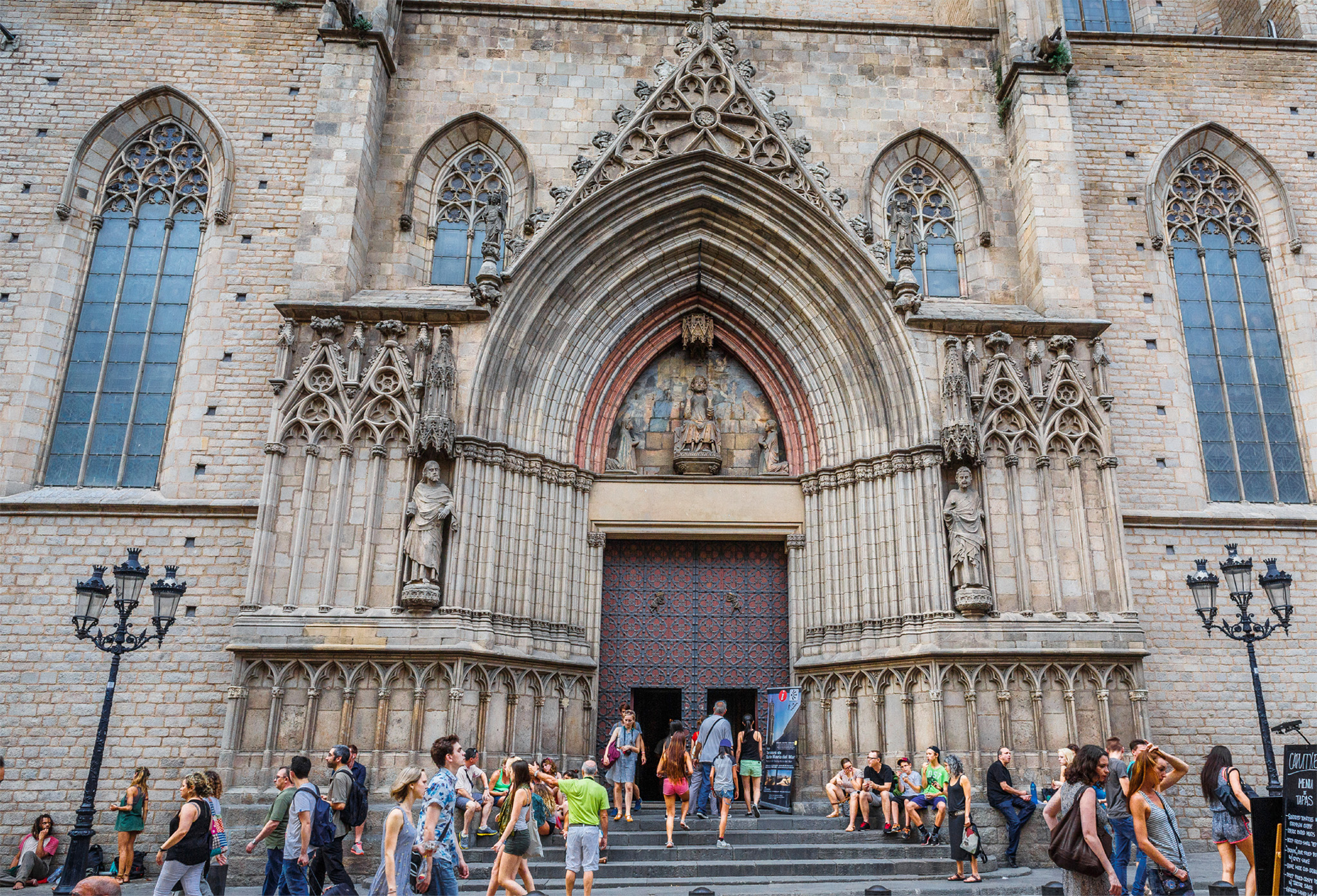
t The Gothic-style Basílica de Santa Maria del Mar, a prominent landmark in the Ribera district
This is the city’s only example of a church entirely in the Catalan Gothic style. Work began in 1329 and it took just 55 years to build, with money donated by merchants and shipbuilders. The speed gave it a unity of style. The west front has a 15th-century rose window of the Coronation of the Virgin. More stained glass, from the 15th to 18th centuries, lights the nave and aisles.
The interior is noted for its simplicity and great acoustics, as demonstrated during the concerts held here. Unfortunately, the choir and furnishings were burned in the Civil War.
For an amazing view, take a guided tour of the church’s rooftop. Visits are at 1:15pm, 2pm, 3pm and 5:15pm daily.
Founded by Barcelona’s chocolate- and pastry-makers’ union, this museum celebrates the history of one of the most universally loved foodstuffs, from the discovery of cocoa in South America to the invention of the first chocolate machine in Barcelona. This confectionery tale is told through old posters, photographs and footage. The real thing is displayed in a homage to the art of the mona, which was a traditional Easter cake that evolved over the centuries into an edible sculpture. Every year, pâtissiers compete to create the most imaginative piece, decorating their chocolate versions of well-known buildings or folk figures with jewels, feathers and other materials. The museum shop sells – you guessed it – all manner of chocolate goods.
The most authentic medieval street in the city is a narrow lane, overshadowed by gargoyles and roofs that almost touch overhead. The Gothic palaces that line it date back to Catalonia’s expansion in the 13th century. Almost all of the buildings were modified over the years, particularly during the 17th century. Only Casa Cervelló-Guidice at No 25 retains its original façade.
The Museu Etnològic i de Cultures del Món (Museum of Ethnology and World Cultures), in the 16th-century palaces at No 12, imaginatively displays more than 700 exhibits from around the world.
Located at No 22 is one of the city’s best-known cava bars, El Xampanyet.
"
Museu Etnològic i de Cultures del Món
§ 93 256 23 00 # 10am–7pm Tue–Sat, 10am–8pm Sun & public hols

t Walking past the 17th-century buildings on Carrer de Montcada
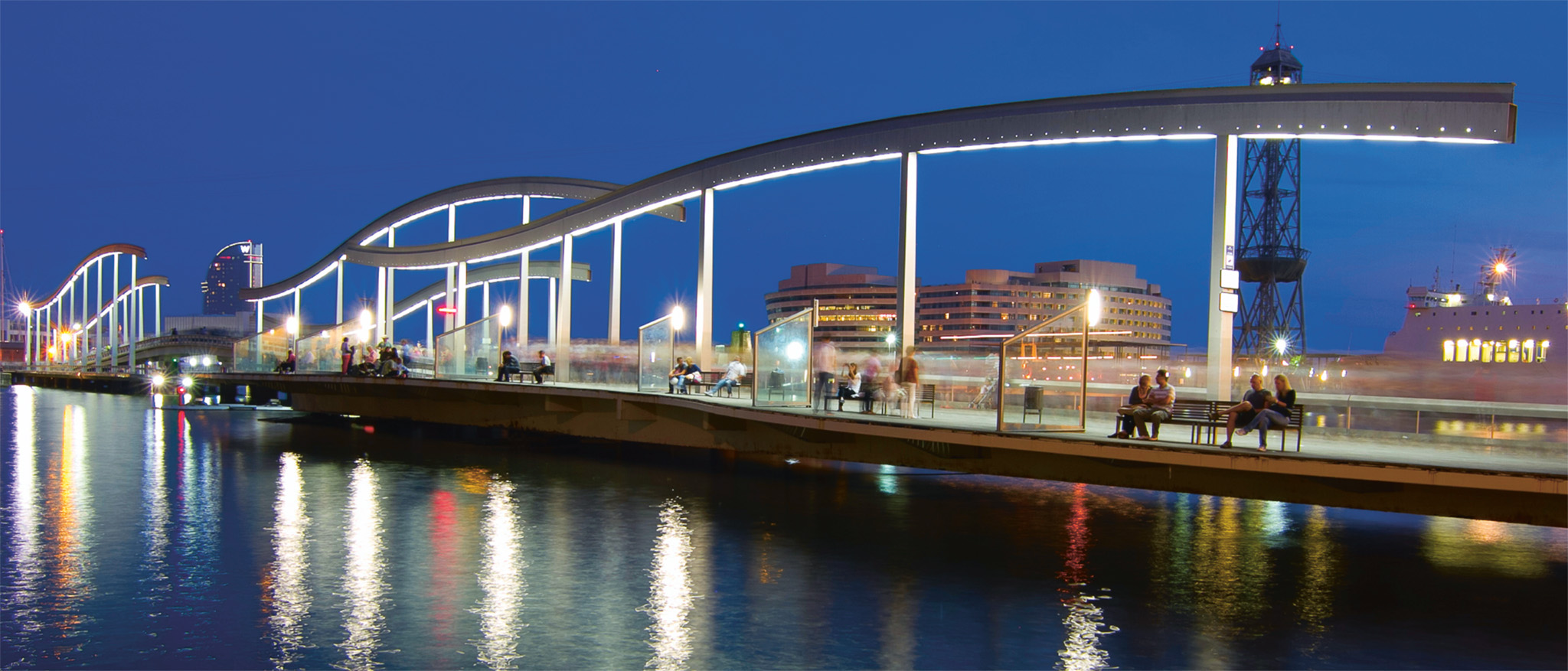
t The modern Rambla de Mar bridge on the waterfront at Port Vell
The city’s leisure port is at the foot of La Rambla, just beyond the old customs house, which was built in 1902 at the Portal de la Pau, the former maritime entrance to the city, where steps lead into the water. To the south, the Moll de Barcelona, with a World Trade Centre, serves as the passenger pier for visiting cruise ships. In front of the customs house, La Rambla is linked to the yacht clubs on the Moll d’Espanya by Rambla de Mar – a futuristic swing bridge and pedestrian jetty, designed in 1994. The Moll d’Espanya (moll meaning quay, wharf or pier) has a shopping and restaurant complex, the Maremagnum, plus L’Aquarium with an underwater tunnel through an enormous shark-filled tank.
The Moll de la Fusta (Timber Wharf), with terrace cafés, has red structures inspired by Van Gogh’s painting of the bridge at Arles. At the end of the wharf stands El Cap de Barcelona (Barcelona Head), a 20-m (66-ft) sculpture by Pop artist Roy Lichtenstein.
" =
L’Aquàrium
# Hours vary, check website ∑ aquariumbcn.com

Great View
Golondrinas
Board a golondrina (“swallow”) – a small double-decker boat – for a sightseeing trip around Port Vell. The tours last from 40 minutes to an hour and go out beside the steep, castle-topped hill of Montjuïc towards the industrial port. It’s a great way to see the city.
The most dramatic project for the 1992 Olympics was the demolition of the old industrial waterfront and the laying out of 4 km (2 miles) of promenade and pristine sandy beaches. Suddenly Barcelona seemed like a seaside resort. At the heart of the project was a 0.6 sq km (¼ sq mile) new estate of 2,000 apartments and parks called Nova Icària. The area is still popularly known as the Vila Olímpica because the buildings originally housed the Olympic athletes.
On the seafront there are twin 44-floor blocks, two of Barcelona’s tallest skyscrapers, one occupied by offices and the other by the Hotel Arts. They stand beside a bustling marina, which was also built in 1992. The marina is the setting for several good restaurants and bars.
Barcelona’s fishing “village”, which lies on a triangular tongue of land jutting into the sea just below the city centre, is known for its fish restaurants and port-side cafés.
Barceloneta was built by the architect and military engineer Juan Martín de Cermeño in 1753 to rehouse people made homeless by the construction of the Ciutadella fortress. Since then it has largely housed fishermen though it is now full of short-let holiday flats. Laid out on a grid system crammed with narrow houses of two or three floors, the area has a friendly air.
In the small Plaça de la Barceloneta is the Baroque church of Sant Miquel del Port, also by Cermeño. The large central square is dominated by a modern covered market.
Today, the remnants of Barceloneta’s fishing fleet are based in the nearby industrial docks by a small clock tower. On the opposite side of this harbour is the Torre de Sant Sebastià, terminus of the cable car that runs across the port, via the World Trade Centre, to Montjuïc. Ricardo Bofill’s iconic Hotel W presides over Barceloneta beach.
Did You Know?
Hotel W, on Barceloneta beach, is known as “La Vela” (The Sail).
The great galleys that made Spain a major seafaring power were built in the sheds of the Drassanes (shipyards), which now house the maritime museum. These royal dry docks are the largest and most complete surviving medieval complex of their kind in the world. They were founded in the mid-13th century, when dynastic marriages uniting the kingdoms of Sicily and Aragón meant that better maritime communications between the two became a priority. Three of the yards’ four original corner towers still survive.
Among the vessels to slip from the Drassanes’ vaulted halls was the Real, flagship of Don Juan of Austria, the illegitimate son of Carlos I (the Holy Roman Emperor Charles V ), who led the Christian fleet to victory against the Turks at Lepanto in 1571. The museum’s showpiece is a full-scale replica decorated in red and gold.
The renovated halls of the Museu Marítim now host temporary exhibitions with a maritime theme, as well as displaying some historic boats. Three times a month, the charming Jardins de Baluard, a walled garden just behind the museum, is open to the public. Here, you can admire Barcelona’s only surviving medieval city gate. The admission ticket also includes a visit to the Santa Eulàlia, a restored century-old schooner, which is moored a short walk away in the Port Vell.
The Columbus Monument atop the Portal de la Pau (the “Gate of Peace”) was designed by Gaietà Buigas for the 1888 Universal Exhibition.
The 60-m (197-ft) cast-iron monument marks the spot where Christopher Columbus stepped ashore in 1493 after discovering America.
There is a very small viewing platform at the top of the monument, above which a 7-m (23-ft) bronze statue of Columbus points out to sea, towards the New World.

t Bronze statue of Columbus, Monument a Colom
EXPERIENCE Old Town

Barcelona Fiestas
La Mercè
Our Lady of Mercy is honoured on 24 September.
Els Tres Tombs
On 17 January horsemen ride three times through the city’s streets.
Dia de Sant Ponç
Stalls along Carrer Hospital sell herbs, honey and candied fruit on 11 May.
La Diada
11 September is Catalonia’s special day.
Festa Major
Each district tries to outdo the beauty of its neighbours’ decorations.
